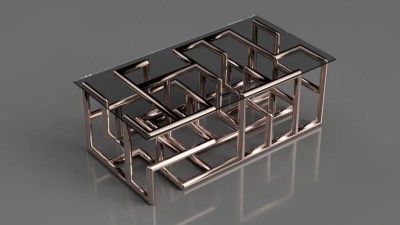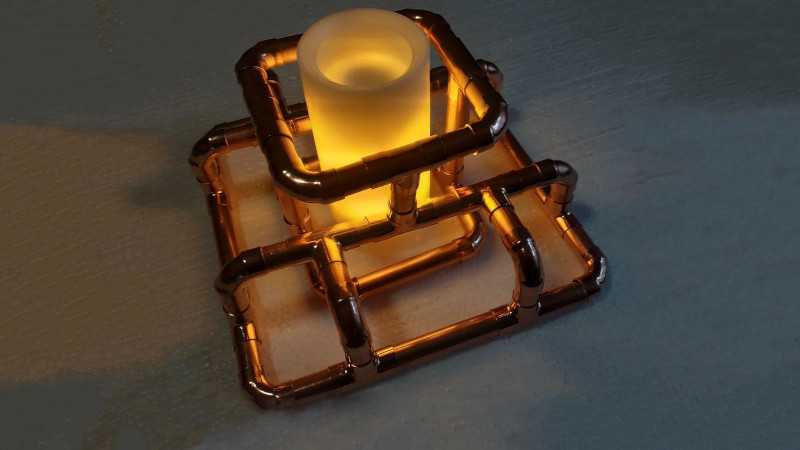Copper is a material with many applications; typically, it’s used for electrical wiring or in applications where good heat conductivity is a requirement. However, it can also make for an attractive material in furnishings, which [Andrei Erdei] decided to explore.

[Andrei]’s work began in OpenSCAD, where he wrote scripts to enable the quick and easy assembly of various designs. The modular nature of commercially-available copper pipe and fittings allows complex structures to be assembled, particularly if you’re a fan of 90-degree bends. The final renders of some of these designs are impressive, with the coffee table design a particular highlight. Staying conceptual wasn’t enough, however, so [Andrei] set out to build one of his designs. Constructing a table lamp shroud out of copper parts was successful, though the real components have flanges and other features that aren’t represented in the rendering.
It’s a project that shows the value of tools such as OpenSCAD to aid the design process before committing to cutting real-world materials. While the designs on screen aren’t perfect representations of what’s possible in reality, it still proves to be a useful guide.
We’re a fan of the aesthetic, and would love to see more done with copper pipe as a construction kit. Global ore prices may limit experimentation, however. Alternatively, you can always harvest the metal from scrap!
















This reminds me of my ultra simple version of Laptop/Tablet stand constructed so kids in my primary school, had to build their version in class.
Here a build video (sorry only in Slovenian language)
https://youtu.be/PTW-xe1_NnM
Make the inside of one’s computer look like a steampunk prop. Merge the RGB trend, and it’ll be a cybersteampunk prop.
Noes, attack of the Windows 3.11 screensavers (pipes)
https://www.youtube.com/watch?v=MKqrLGFoK9E
You knew it was going to be a good day when you spotted the hidden teapot.
This feels like a waste of expensive copper.
It’s obviously cheap enough to do it with… so corner the market and make the price go up so ppl don’t “waste” it.
So how you feel about gold jewelry, because this is, what, 1/80 the price of gold, and you actually get a table from it.
It’s a better use than shoving it up your ass.
Hmmmm, got a point there.
I agree Emyr Not only that but a table, a desk… Copper is NOT a very light-weight material. If you wind up moving once or twice, the appeal will very soon be lost.
Back in my radio days I built J poles out of copper pipe. Some of them were pretty spiffy looking.
Back in my mid IT days when people use 10 base 5 Ethernet with vampire taps and AUI connections to the computer, but most of the Ethernet cards also supported 10 base 2, I had a rather elaborate sculpture built out of the unused Tees and terminators that used to ship with the cards. The 10 base 2 was easier in theory but people would take their computers and just leave the cables dangling and hose that entire network segment until we could get their office door unlocked and fix it. I still have a big cluster of that stuff someplace. It is oddly fun to play with.
Let me guess…..law office?
Lol I’ve still got a cluster floating around as well just can’t bring my self to throw them out….
All models are wrong, some are useful.
A tip of the hat to those who can sweat solder those pipes. I was never able to get it down.
It’s straightforward to me, clean ends, tin, assemble, reheat, apply a dab more solder if it’s not filming across the join anywhere, done.
Others have left good tips. Another is to heat the joint on the side opposite where you apply the solder. Once the heat reaches the side you’re applying solder to, you know it’s hot enough.
About sweating copper pipe troubles.
A (lack of a) large enough heat source is one common problem I’ve seen.
The other big one is surface preparation.
This part is as simple as any other soldering job.
Be sure that your cleaning tools,( sandpaper or wire brush) are clean. No dirt, grease, rust or other contaminates. you can’t use the kit brush for scrubbing tires or grout, dirt, glue etc….
And you can’t use the sandpaper for cleaning paint, rust, same rules apply here.
When either one gets grubby, discard or relegate them to the general usage box, never to be used for solder work again.
Otherwise you just keep spreading the contaminates all over the copper and solder wont flow and stick.
Dirt, grease, paint and skin oils all will foul our soldering efforts on the electronics bench and just keep in mind they do the exact same thing with plumbing.
Just like with wiring or circuit boards, once you clean the copper, don’t handle the cleaned areas again. Hands just contaminate them.
Now go grab some plumbing bits, a new brush & sandpaper, then give it try!
Is there a shed or office or any pipe shops who does copper piping
Now you know copper is anti-virus, it is going to be more and more railing, guard rail, and the like.
In fact the first use for this purpose in recorded history is in the time of Moses. In Exodus of the OT, brass (or bronze) were used in all the washing and sacrificial furniture since three thousand five hundred years ago.
Then the Lord spoke to Moses, saying: “You shall also make a laver of bronze, with its base also of bronze, for washing. You shall put it between the tabernacle of meeting and the altar. And you shall put water in it, for Aaron and his sons shall wash their hands and their feet in water from it. (Exodus 30: 17-19)
Not just the basin, but also the pots, pans, and other things:
“”Moreover, the Chaldeans broke up the bronze pillars and stands and the bronze Sea in the house of the LORD, and they carried the bronze to Babylon. They also took away the pots, shovels, wick trimmers, dishes, and all the articles of bronze used in temple service.” (2 Kings 25:14)
With all these blood splatters and animal fluid of daily sacrifice, all these biohazard dangers were never a problem during the time of the first and second Temples.
I’ve seen something similar used for traffic lights and “industrial-style” furniture.